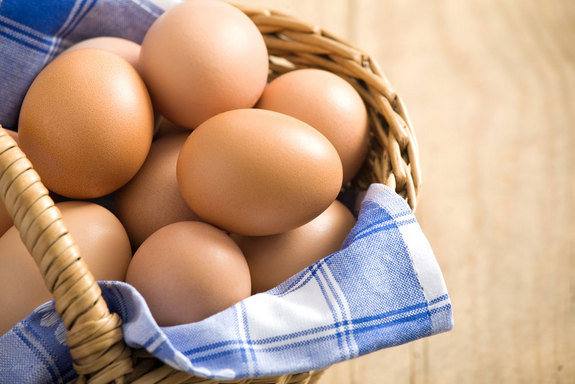The Hard-Boiled Truth About Cooking the Perfect Egg

Cuisiniers and gastronomes share an appreciation for the so-called "65-degree egg" — an egg cooked for long periods at or near 65 degrees Celsius (149 Fahrenheit). But recipes for the ideal egg aren't as scientific as they could be, says food scientist and chef César Vega.
Speaking at a meeting of the American Chemical Society on April 7, Vega, a research manager at Mars Inc., who has a doctoral degree in food science and culinary training from Le Cordon Bleu, explained how cooking can be a platform to engage the public in science. He used the 65-degree egg or its 6X-degree counterparts (for instance, 67 degrees C or 69 degrees C) as an example.
This is a style of cooking known as "sous-vide," which involves heating things in a vacuum (or for eggs, in the shell) at relatively low temperatures. "There's this belief that when you cook an egg sous-vide, once water reaches the temperature you are interested in, how long you cook it for doesn’t matter," Vega told LiveScience. "This is not true."
When an egg is cooked, the proteins in the yolk unravel, a process known as denaturation. Proteins can be denatured by strong chemicals such as acids, mechanical action or heat — as in the case of the 6X-degree egg.
There's a false notion, even among scientists, that proteins have definitive, discrete denaturation temperatures, Vega said. "The belief is, 67 degrees C [153 F] is the temperature at which egg yolk proteins start to coagulate," he said, but that isn't true. It all depends on the thermal history of the egg, he explained: "I can heat it at 35 degrees C [95 F], and if I wait long enough, it will denature it." Boiling the egg denatures it too, but it happens so fast that the textural outcome is different, Vega said. [Top 10 Modern Kitchen Innovations]
Some proteins in the egg yolk denature at higher temperatures than others, Vega found, and more proteins denature the longer the egg is cooked. The hotter the temperature and the longer the cook time, the more viscous the yolk becomes.
To help chefs achieve an egg with their desired texture, Vega has created a graph that shows them what temperatures and cooking times to use. Based on these variables chefs can create eggs with the texture of mayonnaise (yolk proteins that are less denatured), honey — even cookie icing (highly denatured yolk proteins), Vega said. His findings are detailed in a paper on the science of the 6X-degree egg, published in March 2011 in the journal Food Biophysics.
Sign up for the Live Science daily newsletter now
Get the world’s most fascinating discoveries delivered straight to your inbox.
And the science of cooking eggs extends to other foods, too, such as meringues, which are made from whipped egg whites and sugar. Cream of tartar or lemon juice is often added to meringues, but why? It has to do with the degree of acidity, Vega said. Egg whites are slightly basic, or alkaline, which makes the proteins clump together when they're whipped, causing the foam to collapse.
Cream of tartar and lemon juice are both acidic, so adding them to egg whites neutralizes them and they don't clump up as much. "You can whip and whip and whip and the egg whites won't aggregate," Vega said. Garlic juice works really well too, he said, though "It's a little stinky."
Vega blends his passions for science and cooking at his lab at Mars Inc. World-class chefs come to him with their problems or ideas, and he helps them.
"Chefs are very curious minds," he said. "This opens up the possibility to team up with them and listen to their ideas and think through if it's possible to make what they are envisioning."
Follow Tanya Lewis on Twitter and Google+. Follow us @livescience, Facebook & Google+. Original article on Live Science.










